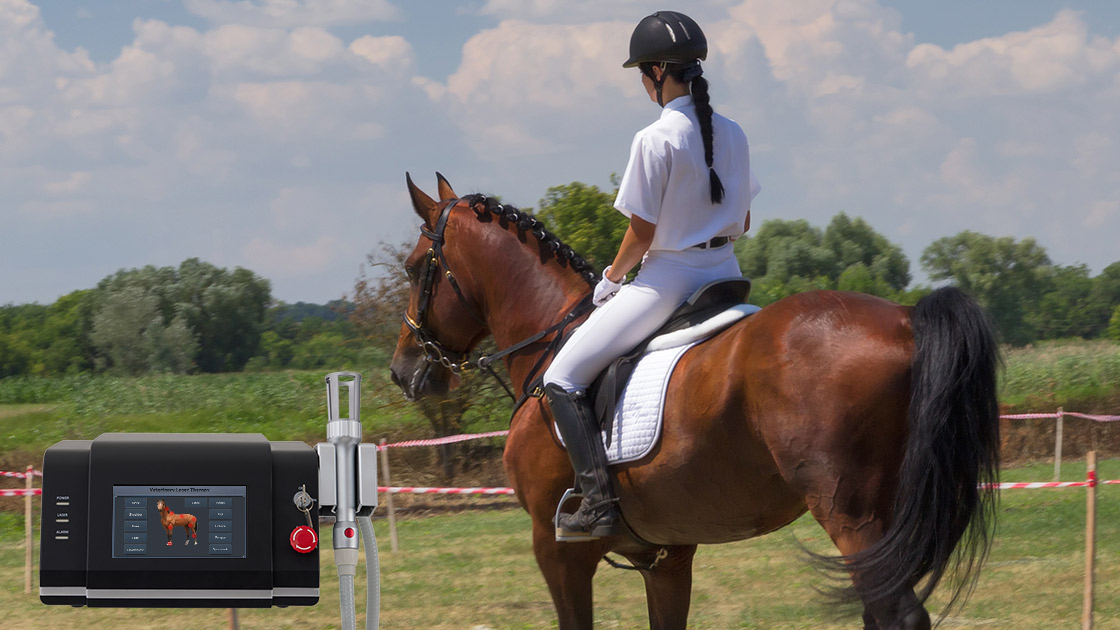Page Contents
Introduction to Laser Therapy for Horses
Laser therapy has increasingly gained popularity as a treatment modality in equine care. This non-invasive technique uses light to promote healing and pain relief, offering significant advantages for managing various conditions in horses. From injuries and wounds to chronic conditions, laser therapy provides a versatile and effective solution. This article explores the types of lasers used on horses, the importance of laser wavelength and frequency, and the specific benefits of Class IV laser therapy for horses.
Types of Lasers Used on Horses
Laser therapy for horses typically involves two main types: low-level laser therapy (LLLT) and high-intensity laser therapy (HILT). Each type offers unique applications and benefits, depending on the horse’s specific needs.
Low-Level Laser Therapy (LLLT): Also known as cold laser therapy, LLLT uses low-intensity light to stimulate cellular function and promote healing. Veterinarians commonly use LLLT for minor injuries, wounds, and inflammation. This therapy is particularly effective for surface-level conditions and provides a gentle treatment option for sensitive areas.
High-Intensity Laser Therapy (HILT): This type of laser therapy uses higher intensity light to penetrate deeper into tissues. HILT treats deeper injuries and more severe conditions such as muscle strains, ligament injuries, and chronic pain. The increased intensity allows for more substantial therapeutic effects and quicker recovery times.
Additionally, Class IV Laser Therapy, a form of HILT, uses the most powerful and versatile lasers in equine therapy. These lasers offer a range of wavelengths and intensities, allowing for tailored treatments based on the horse’s specific needs. Class IV laser therapy effectively treats both superficial and deep tissues, making it ideal for a wide range of conditions.
Understanding Laser Wavelength and Frequency
The effectiveness of laser therapy heavily depends on the wavelength and frequency of the light used. These factors determine how deeply the light penetrates tissues and how it interacts with cellular structures.
Wavelength: Measured in nanometers (nm), the wavelength of a laser determines the depth of tissue penetration. Shorter wavelengths (600-700 nm) penetrate superficial tissues, making them suitable for treating skin conditions and shallow wounds. Conversely, longer wavelengths (800-1000 nm) penetrate deeper, making them ideal for treating muscles, tendons, and joints.
Frequency: Frequency, measured in Hertz (Hz), refers to the number of light pulses delivered per second. Higher frequencies typically address acute conditions to rapidly reduce pain and inflammation. Lower frequencies target chronic conditions to promote tissue repair and regeneration over time.
Class IV Laser Therapy Benefits for Horses
Class IV laser therapy stands out due to its versatility and effectiveness. Here are some key benefits it offers for horses:
Pain Relief: Class IV lasers provide immediate pain relief by reducing inflammation and promoting the release of endorphins, the body’s natural painkillers. This method is particularly beneficial for horses suffering from chronic pain or acute injuries.
Enhanced Healing: By stimulating cellular activity and increasing blood flow to the treated area, Class IV laser therapy accelerates the healing process. This benefit is crucial for horses recovering from surgery, injuries, or chronic conditions.
Reduced Inflammation: Inflammation commonly causes pain and reduced mobility in many equine conditions. Class IV lasers quickly reduce inflammation, improving the horse’s comfort and ability to move.
Versatility: The adjustable wavelength and frequency make Class IV lasers suitable for a wide range of conditions, from superficial wounds to deep tissue injuries. This versatility allows veterinarians to customize treatments for each horse’s specific needs.
Non-Invasive and Safe: Class IV laser therapy offers a non-invasive treatment option with minimal side effects. It is safe for repeated use and integrates into a comprehensive treatment plan without causing additional stress to the horse.
Conclusion
In conclusion, laser therapy, particularly Class IV laser therapy, provides a promising treatment option for a variety of equine conditions. Its ability to provide pain relief, accelerate healing, and reduce inflammation makes it a valuable tool in modern equine care. As technology advances and more research is conducted, the applications and benefits of laser therapy for horses will continue to expand, providing even greater support for equine health and well-being.
